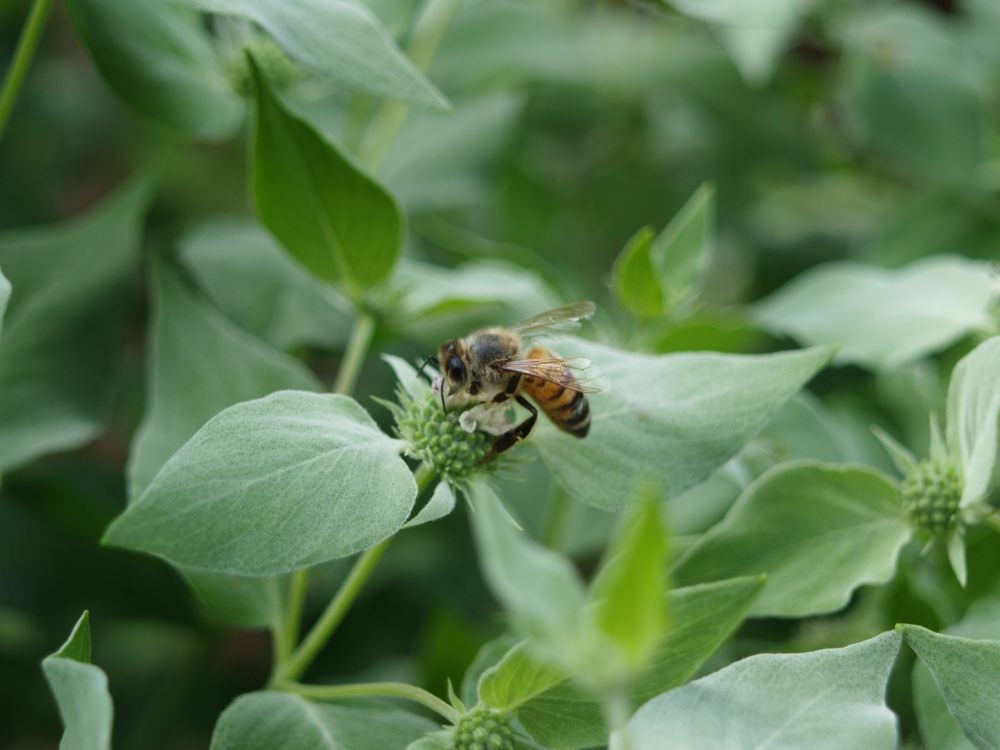At the start of July the hydrangeas are most prominent in the garden, and one or the other will flower into late September. The large blue, pink, and white blooms demand attention, but there are other splendid flowers equally deserving, though for shorter periods.
Daylilies (Hemerocallis, above) are quite common, but longed lived perennials that thrive in a range of soils in full to part sun. If you will bother to read references you’ll find that most perennials prefer deep and moist, well drained soils, but this circumstance is created only with considerable labor and expense, or by relocating the garden to one of the few parts of this planet with ideal planting conditions.
Simply, daylilies will grow well in nearly any spot that you care to plant them, and then will require little care and no bother except to protect them from nibbling deer. Some flower for a few weeks and others for months, but all are exceptional plants, and worthy of inclusion in any garden.
With silver gray foliage and lavender blooms Russian sage (Perovskia atriplicifolia, above) looks to be drought tolerant, and in fact it seems happy in the harshest, driest soils so long as it receives adequate sunlight. I’ve found that it works well to fill gaps between shrubs that prevent it from flopping about.
I’ve grown Mountain mint (Pycnanthemum tenuifolium, above) only for a few years, and already the robust clumps top three feet. The tall stems are sturdy, and do not require staking. Somehow, this native perennial is uncommon in commerce, and even many native plant growers neglect it. I have found it to be rugged and tolerant of dry, sun baked clay soil. The flowers are modest, but the uppermost foliage is uniquely dusted in white, almost like powdery mildew, but not so that the leaves curl, and even in the most severe summer heat the foliage looks fresh and vigorous.
I rarely miss the opportunity to run my hands through the fragrant foliage as I wander past, though the neighboring hummingbird mint (Agastache, above) that is equally tall and nearly as fragrant will do if one or the other is being visited by a large number of bees.
The Shasta daisies (Leucanthemum x superbum ‘Becky’, above) have grown taller than usual this year, I suppose a consequence of the regular spring rainfall. The stems remain stiffly upright (though angled toward the evening sun), and they sway in unison to the rhythm of the breeze.
The stems of plume poppy (Macleaya cordata, above) are tall and gently arching. At the margins stems might arch to nearly touch the ground, but stems in the middle of the clump stand much more erect. The size of clump depends on how much space it is given, and lesser perennials do not stand a chance in its path. Tall cryptomerias and miscanthus have proven themselves worthy of containing the plume poppy, and with a bit of space and some planning to keep it under control this is a marvelous tall perennial.
Later in the week we’ll explore some of the garden’s smaller perennials, as well as a a few summer flowering bulbs. Now, the skies have darkened and a ferocious storm is brewing. In the morning I will tour the garden to assess any damage, which is likely to be no more severe than a few broken branches. The hydrangeas were seriously wilting this afternoon, so the rain is quite welcome.
I planted mountain mint in my garden about a decade ago. Don’t be concerned with the name “mint” as it is not invasive at all. The blooms are very nondescript but the pollinators love it.
Mountain mint has quickly become one of my favorites, and I can’t figure why it’s not more popular. I’m certain that if the flowers were showier it would gain more favor, but it is vigorous and beautiful without being too aggressive.
now, where would i get some mountain mint, and would it grow here in Wake Forest?
Our Shasta daisies too curve toward the evening light. I’m constantly amazed at this, and how straight hey are in the morning. Mixed in with the purple coneflower, they’re been producing blooms for weeks already!
I bought my mountain mint at the garden center, but I haven’t seen it in any others. It can be purchased though mail order from Lazy S’s Farm Nursery – http://www.lazyssfarm.com/
Lazy S’s sells lots of oddballs that aren’t commercially viable.